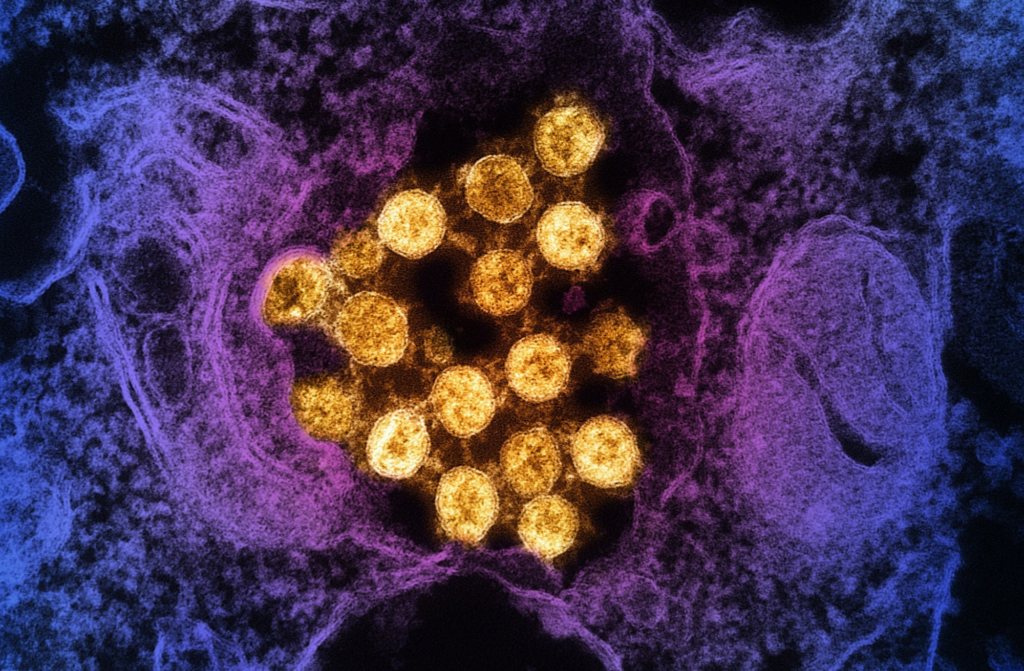By Dr. Sanchari Sinha Dutta, Ph.D.Jan 14 2024

A recent study published in the journal Eurosurveillance claims that the recent upsurge in cases with the JN.1 variant of severe acute respiratory syndrome coronavirus 2 (SARS-CoV-2) may not be due to the immune escape ability of the variant.
Rapid Communication: Humoral immune escape by current SARS-CoV-2 variants BA.2.86 and JN.1, December 2023. Image Credit: NIAIDRapid Communication: Humoral immune escape by current SARS-CoV-2 variants BA.2.86 and JN.1. December 2023. Image Credit: NIAID
Background
Severe acute respiratory syndrome coronavirus 2 (SARS-CoV-2), the causative pathogen of coronavirus disease 2019 (COVID-19) pandemic, is a respiratory virus belonging to the human beta-coronavirus family. Many variants of SARS-CoV-2 with improved immune fitness have emerged throughout the pandemic and triggered several distinct pandemic waves across the world.
The omicron variant of SARS-CoV-2 emerged for the first time in South Africa in late 2021. The BA.2 lineage was one of the major omicron descendent lineages that showed significantly higher transmissibility and infectivity. The BA.2.86 is a notable descendent lineage of BA.2 that emerged in 2023. This variant has higher numbers of spike protein mutations than previously emerged variants.
The most recently emerged JN.1 variant is a descendent of BA.2.86 that has gained significantly higher transmission ability. With an additional substitution mutation (L455S) in the spike protein, the JN.1 variant exhibits faster circulation than BA.2.86 worldwide.
In this study, scientists investigated immune escape potencies of recent JN.1, BA.2.86, and earlier variants.
Study design
The scientists collected serum samples from a total of 39 vaccinated and SARS-CoV-2-exposed healthy individuals and assessed virus neutralization titers in these samples against seven different viral variants, including B.1, BA.2, BA.5, XBB.1.5, EG.5.1, BA.2.86 and JN.1.
The serum samples were collected in September 2023 when the SARS-CoV-2 EG.5.1 variant was predominantly circulating in the study region (Berlin and surrounding regions) for at least 1.5 months. Plaque reduction neutralization tests were performed on transmembrane serine protease (TMPRSS 2)-expressing monkey kidney epithelial cells to determine neutralization titers.
Important observations
The assessment of neutralization titers revealed the highest neutralizing reactivity against the ancestral B.1 variants, followed by BA.2 and BA.5 variants. This is because of the pre-existing anti-SARS-CoV-2 immunity induced by COVID-19 vaccination or previous SARS-CoV-2 infection.
For the BA.2.86 variant, the reduction in neutralizing titers was 20-fold compared to the ancestral B.1 variant. No neutralizing titers were detected in 11 out of 39 participants. Compared to the BA.2.86 variant, the JN.1 variant showed no further reduction in neutralizing titers. This observation remained the same when the participants with and without XBB variant exposure were categorized into two groups.
Study significance
The study finds that both BA.2.86 and JN.1 variants of SARS-CoV-2 have comparable immune escape ability. Both variants have a significantly higher ability to escape pre-existing anti-SARS-CoV-2 immunity compared to earlier variants. This could explain the recent predominance of BA.2.86 and JN.1 variants.
However, a higher immune fitness may not be the reason for the recent upsurge in JN.1 cases, as the variant does not have any additional immune escape ability relative to the BA.2.86 variant. There might be some other factors responsible for improved viral transmissibility and infectivity. Future studies are needed to understand the dynamics of JN.1 transmissibility.
The scientists have compared their findings with existing evidence and found that they are not in accord with two previous studies that used a higher proportion of individuals with an infection or vaccination history with XBB variants.
A significant proportion of participants could not exhibit detectable neutralizing titers against the most recently circulating viral variants, including XBB.1.5, EG.5.1, BA.2.86, and JN.1. This indicates waning of vaccine- or infection-induced immunity at the population level, which could increase the incidence of re-infection in upcoming winter months in the northern hemisphere.
Journal reference:
Jeworowski Lara M, Mühlemann Barbara, Walper Felix, Schmidt Marie L, Jansen Jenny, Krumbholz Andi, Simon-Lorière Etienne, Jones Terry C, Corman Victor M, Drosten Christian. Humoral immune escape by current SARS-CoV-2 variants BA.2.86 and JN.1, December 2023. Euro Surveill. 2024;29(2):pii=2300740. https://doi.org/10.2807/1560-7917.ES.2024.29.2.2300740, https://www.eurosurveillance.org/content/10.2807/1560-7917.ES.2024.29.2.2300740

Leave a Reply